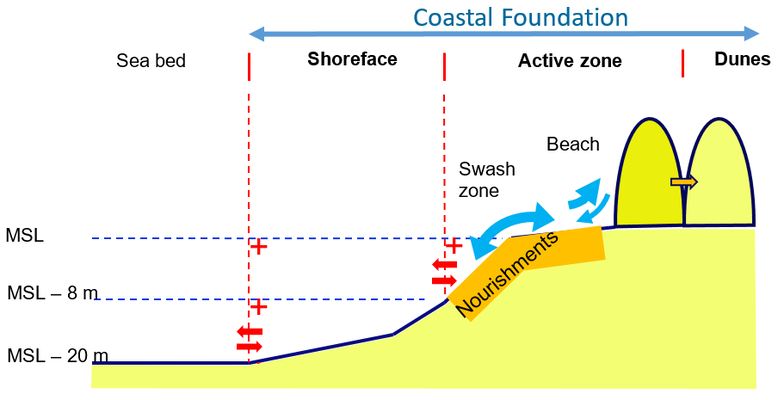Laura Brakenhoff1*, Ellen Quataert2, Marcel Taal2, Quirijn Lodder1
1Rijkswaterstaat, The Netherlands; 2Deltares, The Netherlands
*Corresponding author: laura.brakenhoff@rws.nl
Introduction
Starting in 1990, the strategic goals of Dutch coastal management are to sustainably maintain the flood protection and to sustainably preserve other functions of the dune areas (Ministry of Transport and Water Management (MinV&W), 1990). In 2000, an extra tactical goal was added; besides preserving the coast line, also the sediment budget of the Coastal Foundation should be kept in equilibrium with sea level rise (MinV&W, 2000). The Coastal Foundation is defined here as the area between 20 m water depth and the inner dunes. In practice, these goals are achieved through sandy nourishments on the shoreface, beach or channel walls.
Under accelerated sea level rise, it is unclear whether we can achieve the above-mentioned policy goals with nourishments only. Therefore, it is essential to know how much sand is needed to protect and preserve the coast. To answer these (and many more) questions, the Sandy Coast theme within the Knowledge Programme Sea Level Rise (KP SLR) was set up.
Objective and Methods
In this project, Deltares and Rijkswaterstaat studied the physical impact of 0.5, 1, 2, 3 and 5 m of sea level rise on the sediment and nourishment demand of the coastal system. First, it was studied which part of the Coastal Foundation has been receiving the sediment that was nourished over the last 57 years. It was concluded that only this part (the ‘active zone’) should grow with sea level rise, instead of the Coastal Foundation as a whole.
The cumulative sediment demand of the system (in m3/year) is determined by multiplying the area of the active zone by each SLR-value. This sediment demand is then corrected by the expected sediment transport in/out of the system (e.g. transport towards the Wadden Sea).
The sediment demand can be seen as a morphological characteristic of the coastal system. The nourishment volumes are not always equal to this value. At the Holland coast, the nourishment volumes are higher than the sediment demand, in order to keep the coastal towns (‘bolwerken’) in place. At the North Sea coast of the Wadden, the nourishment volumes are smaller than the sediment demand, because currently, around 50% of the sediment export to the Wadden Sea needs to be compensated.
Results
The area in which the nourished sand spreads is much smaller than the Coastal Foundation. In general, it extends to a water depth of approximately 10 m. This implies that the sediment demand under (extreme) sea level rise is smaller than previously assumed. For a sea level rise of 5 m, the cumulative sediment demand for the entire Dutch coast ranges between 7 and 12×109 m3. The nourishment demand ranges between 5 and 12×109 m3. Even though these are very large volumes of sand, continuing the current strategy of nourishing 11×106 m3/y until the year 2200 results in almost 2×109 m3 of nourished sand. Assuming that 5 m sea level rise occurs in 2200 thus increases the nourishment volumes by only 2.5 to 6 times with respect to current volumes.
Although the results regarding the nourishment volumes are encouraging, it is still imperative that spatial planning reservations are made regarding sediment availability. At present, it is sometimes difficult to find the correct sand for nourishments, these issues are likely to increase in the future without appropriate planning.

Cross-section of a coastal profile, indicating the difference between the Coastal Foundation and the Active zone, in which the nourishments spread.
References
Ministry of Transport and Water Management (1990). Kustverdediging na 1990.
Ministry of Transport and Water Management (2000). Derde kustnota: traditie, trends en toekomst


